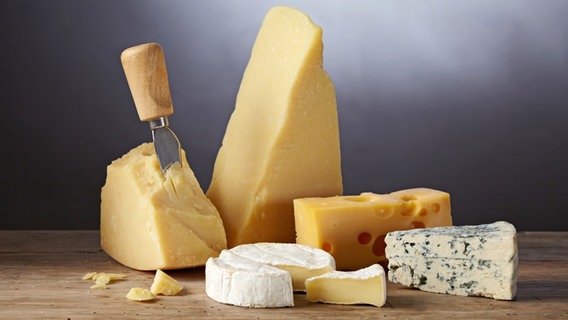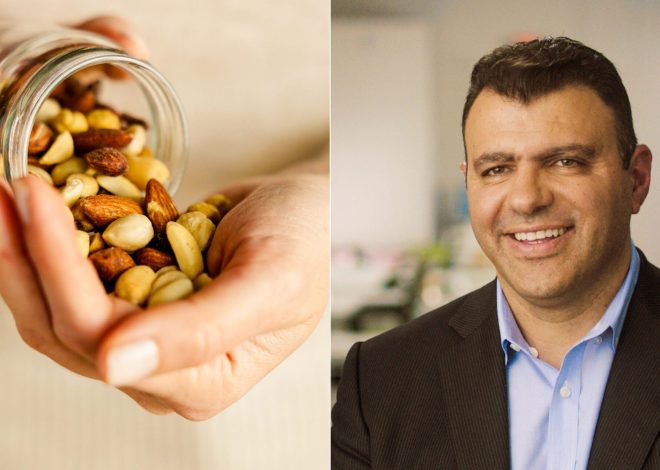
Cheese: How healthy is it really? | NDR.de – Guide
As of: May 17, 2024 10:53 a.m
| from the
Cheese provides important nutrients such as proteins, calcium and vitamins. But it is also high in calories and often contains a lot of saturated fat and salt. The type of cheese and the amount are crucial.
On average, every German eats almost 24 kilograms of cheese per year. Whether on bread, as a snack or for baking oven dishes – cheese is popular and healthy in moderation. It can support muscle building, strengthen teeth and bones and support our microbiome. But according to the German Nutrition Society (DGE), more than two slices per day are not recommended.
Lots of protein in mozzarella, cottage cheese and feta
Cheese contains many valuable proteins. That’s why it’s also popular with athletes, because a diet rich in protein is healthy and has a beneficial effect on building muscle. If you want to get protein primarily through cheese, it’s best to use mozzarella, feta and cottage cheese. They are low in calories and particularly rich in protein. But the food also contains other important nutrients such as calcium and A and B vitamins.
Emmental cheese is rich in calcium
Calcium can help strengthen bones and teeth, it is important for the transmission of stimuli in our nervous system and muscles and keeps our cell walls stable. Emmental cheese, for example, is particularly rich in calcium. Just two slices of it cover the recommended daily amount of the mineral. But Parmesan and Gouda are also rich in calcium.
Lots of vitamin B2 in ricotta, Camembert, mountain cheese and Emmental cheese
When it comes to vitamins, cheese mainly contains vitamin A and vitamin B2, B5 and B12. In this country, milk and milk products such as cheese are the main source of vitamin B2, also known as riboflavin. The vitamin is important for cell function, but also for growth and development. In the body, as a component of enzymes, it is involved in numerous metabolic processes. Whey cheeses such as ricotta, Camembert, mountain cheese and Emmental are particularly high in riboflavin. It is estimated that up to 20 percent of older people in Europe suffer from a deficiency of this vitamin. Vitamin B5, also called pantothenic acid, is mainly found in soft cheese. Like riboflavin, it is involved in many metabolic processes in the body.
High in fat, high in calories and salt
Despite the many healthy ingredients, you should eat cheese in moderation because it is rich in fats. It is also often high in calories and contains a lot of salt. However, this is not the case for all types, so it is worth comparing the different types of cheese in terms of their nutritional values and salt content.
Lots of salt in feta, gouda and parmesan
High salt consumption promotes cardiovascular problems such as the development of high blood pressure and should therefore be avoided. The salt content is particularly high in blue cheese and brine-ripened cheeses such as feta. Long-ripened cheeses such as Parmesan and Gouda also contain a relatively high amount of salt. This is where conscious consumption as a luxury food comes in handy.
Camembert, mountain cheese and cheddar contain a lot of fat
It’s also worth taking a closer look at the fat content. Because cheese usually contains a lot of fat. These include both healthy unsaturated fatty acids and the significantly less healthy saturated fatty acids. The latter have a negative impact on cholesterol levels, increase the risk of cardiovascular disease and promote inflammation in the body. Cheeses that are high in fat and therefore also high in calories are Camembert, butter cheese, Gouda, Gorgonzola, mountain cheese, Cheddar and Parmesan.
Low-fat alternative: Harz cheese and co
Mozzarella, feta and especially sour milk cheese are low in fat. The latter are made from skimmed milk, which is first processed into sour milk quark – hence the name. Their dry matter fat content is less than ten percent, making them lean cheeses. Representatives of this category are Harz cheese, Mainz cheese, hand cheese and basket cheese.
Recommendation: A maximum of two slices of cheese per day
In 2024, the German Nutrition Society (DGE) published new nutritional recommendations and also adjusted the recommendation for cheese consumption in Germany. She currently advises a maximum of two servings of milk or milk products per day. This corresponds to 500 grams of milk or around 50 to 60 grams of cheese. Since a normally cut slice of cheese weighs around 30 grams, this corresponds to a maximum of two slices of cheese per day if no other dairy products are consumed. This takes into account the fat, salt and calorie content as well as the ecological footprint of the food, because the CO2 balance of cheese production is poor and cheese is therefore not very climate-friendly.
Raw milk cheese beneficial for microbiome
Cheese made from pasteurized milk is frowned upon by cheese lovers. The accusation: Pasteurized cheese is “dead” and no longer has anything to do with the original craft product and cultural asset of cheese. This refers to the ultra-high heating of milk before cheese is made from it – so-called pasteurization. The milk is heated to over 72 degrees Celsius for a short time (15 seconds to a few minutes). This kills microorganisms such as bacteria and fungi in the natural product. This allows the milk to last longer and prevents the transmission of potentially pathogenic germs. The process also kills all naturally occurring, non-disease-causing microorganisms, such as lactic acid bacteria. This means that the positive effect of cheese on the intestinal microbiome, the bacterial colonization of our intestines, is lost. It is positively influenced by raw milk cheese and becomes more diverse. A healthy microbiome is important for our immune system, protects against allergies, stimulates intestinal movement and is central to regulated bowel movements.
No raw milk cheese during pregnancy
Raw milk cheese should not be consumed during pregnancy as germs that can potentially cause illness to mother and child can be transmitted. These include listeria, for example. These are bacteria that can cause what is known as listeriosis. People with healthy immune systems rarely become ill through contact with the bacteria. However, pregnant women are at increased risk of illness and the bacteria could also be passed on to the child. This can lead to miscarriages, premature births or stillbirths or to an infection of the newborn with serious consequences such as pneumonia, meningitis or blood poisoning.
Cheese made from raw milk is always labeled
If a cheese was made from raw milk, this must be stated on the product. If there is no special indication “made from raw milk”, the cheese can be safely consumed by pregnant women. Pregnant women should also avoid other types of cheese such as soft cheese, semi-solid blue cheese such as Gorgonzola, cheese with surface smear such as Munster, Limburger, Handkäse or Tilsiter, as they can also contain potentially pathogenic bacteria.
Which cheese if you are lactose intolerant?
Even people with lactose intolerance don’t have to go without cheese. Cheeses and hard cheeses that have matured for a particularly long time can be eaten almost without hesitation. As it ripens, the milk sugar in the cheese, lactose, is increasingly broken down. The longer the ripening time, the lower the lactose content. Cheeses that are suitable for lactose intolerant people are Parmesan, Emmental or Gouda. It’s best to test for yourself which types of cheese can be eaten without any symptoms. It is recommended to always consume dairy products in small portions throughout the day and with a meal.
Myth or truth: Does cheese really close your stomach?
It’s true: Cheese can help you feel full. When the protein- and fat-rich cheese eaten reaches the first section of the small intestine, the enterohormone GIP (Gastric Inhibitory Peptide) is released into the bloodstream. This causes us to feel full via receptors in the central nervous system. In addition, another enterohormone, secretin, is released. It delays gastric emptying into the small intestine. As a result, the stomach feels fuller, which can also help you feel full.
Further information


Ethel Purdy – Medical Blogger & Pharmacist
Bridging the world of wellness and science, Ethel Purdy is a professional voice in healthcare with a passion for sharing knowledge. At 36, she stands at the confluence of medical expertise and the written word, holding a pharmacy degree acquired under the rigorous education systems of Germany and Estonia.
Her pursuit of medicine was fueled by a desire to understand the intricacies of human health and to contribute to the community’s understanding of it. Transitioning seamlessly into the realm of blogging, Ethel has found a platform to demystify complex medical concepts for the everyday reader.
Ethel’s commitment to the world of medicine extends beyond her professional life into a personal commitment to health and wellness. Her hobbies reflect this dedication, often involving research on the latest medical advances, participating in wellness communities, and exploring the vast and varied dimensions of health.
Join Ethel as she distills her pharmaceutical knowledge into accessible wisdom, fostering an environment where science meets lifestyle and everyone is invited to learn. Whether you’re looking for insights into the latest health trends or trustworthy medical advice, Ethel’s blog is your gateway to the nexus of healthcare and daily living.






